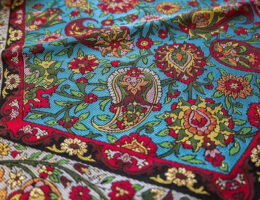IRAN ART EXHIBITION: PERSIAN CARPET IS A WORLD FAMOUS ART
A Persian carpet (Persian: فرش ايرانى) or Persian rug also known as Iranian carpet, is a heavy textile made for a wide variety of utilitarian and symbolic purposes and produced in Iran (historically known as Persia), for home use, local sale, and export. Carpet weaving is an essential part of Persian culture and Iranian art. Within the group of Oriental rugs produced by the countries of the “rug belt”, the Persian carpet stands out by the variety and elaborateness of its manifold designs.
Persian rugs and carpets of various types were woven in parallel by nomadic tribes in village and town workshops, and by royal court manufactories alike. As such, they represent miscellaneous, simultaneous lines of tradition, and reflect the history of Iran, Persian culture, and its various peoples. The carpets woven in the Safavid court manufactories of Isfahan during the sixteenth century are famous for their elaborate colors and artistical design, and are treasured in museums and private collections all over the world today. Their patterns and designs have set an artistic tradition for court manufactories which was kept alive during the entire duration of the Persian Empire up to the last royal dynasty of Iran.
Carpets woven in towns and regional centers like Tabriz, Kerman, Ravar, Neyshabour, Mashhad, Kashan, Isfahan, Nain and Qom are characterized by their specific weaving techniques and use of high-quality materials, colours and patterns. Town manufactories like those of Tabriz have played an important historical role in reviving the tradition of carpet weaving after periods of decline. Rugs woven by the villages and various tribes of Iran are distinguished by their fine wool, bright and elaborate colours, and specific, traditional patterns. Nomadic and small village weavers often produce rugs with bolder and sometimes more coarse designs, which are considered as the most authentic and traditional rugs of Persia, as opposed to the artistic, pre-planned designs of the larger workplaces. Gabbeh rugs are the best-known type of carpet from this line of tradition.

IRAN ART EXHIBITION: As a result of political unrest or commercial pressure, carpet weaving has gone through periods of decline throughout the decades. It particularly suffered from the introduction of synthetic dyes during the second half of the nineteenth century. Carpet weaving still plays a critical role in the economy of modern Iran. Modern production is characterized by the revival of traditional dyeing with natural dyes, the reintroduction of traditional tribal patterns, but also by the invention of modern and innovative designs, woven in the centuries-old technique. Hand-woven Persian rugs and carpets have been regarded as objects of high artistic and utilitarian value and prestige since the first time they were mentioned by ancient Greek writers.
Although the term “Persian carpet” most often refers to pile-woven textiles, flat-woven carpets and rugs like Kilim, Soumak, and embroidered tissues like Suzani are part of the rich and manifold tradition of Persian carpet weaving.
In 2010, the “traditional skills of carpet weaving” in Fars Province and Kashan were inscribed to the UNESCO Intangible Cultural Heritage Lists.
Hardly any other type of carpet is as well known as Iran’s hand-knotted Persian carpets. Among them, however, some stand out particularly due to their outstanding quality. One of these are from the Isfahan region. An architectonically impressive city whose carpets are as radiant as the buildings. Inspired by the city itself, carpets are knotted in factories with the finest patterns and ornaments.
Hardly any other city has such a high density of experienced knotters who produce some of the finest hand-knotted carpets in the world. With a knotting density of 650,000 knots per square metre upwards, Isfahan carpets are of very fine quality and are therefore among the most sophisticated of all. There are world-famous knotters of Persian carpets from Isfahan. Some of them are for example Seifarian, Entescharf or Davari. The number of carpet manufacturers is also extremely high. The city’s shopping miles are lined with carpet dealers, who are frequented not only by tourists but also by locals.
But one thing is clear: If you want to feel a real Isfahan under your feet, you have to dig a little deeper into your pocket. However, the buyer receives a piece that is extremely difficult to produce in terms of craftsmanship. Such a carpet gives joy through its fine haptics, high attention to detail and the most sophisticated quality.
IRAN ART EXHIBITION: Isfahan, the former capital of Persia, is always worth a visit. It was or is the greatest beauty of the country with its many mosques, such as the famous Emam Mosque and the various palaces. In this context, the Persian saying that Isfahan is half the world can be understood.






